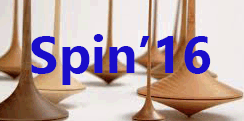Speaker
Description
An Electron-Ion Collider (EIC) is proposed as the first lepton- hadron collider in the world with both beams polarized. The envisioned nuclear physics program requires high polarizations, long polarization lifetimes, and unprecedented capabilities of polarization control in both collider rings. The electron polarization must be longitudinal at the interaction points while the light ion polarization must be adjustable to transverse and longitudinal directions in the whole energy range. This talk presents an elegant spin dynamics design based on figure-8 rings adopted by Jefferson Labs EIC (JLEIC) that meets all of these requirements. A highly polarized electron beam is injected from CEBAF into the electron collider ring at full energy of 3 to 10 GeV. The electron polarization is designed to be vertical in the arcs to minimize spin diffusion and turned to the longitudinal in the straights for experiments. The turning is done by universal spin rotators, which utilize solenoids separated by bends to control the polarization in the whole energy range without affecting the design orbit. The figure-8 shape removes the spin tune energy dependence significantly reducing quantum depolarization as verified by spin tracking simulations. High polarization level is maintained by continuous topoff injection. For ions (p, d, He3, Li6, Li7 ...), the figure-8 booster and collider ring geometries allow one to preserve and control the polarization of any ion species during their acceleration and storage at any energy. Lack of a preferred polarization direction in a figure-8 ring makes it possible to control the ion beam polarization and to stabilize it in any desired orientation by using magnetic field integrals that are small in comparison to those of Siberian snakes and conventional spin rotators. A single weak solenoid is sufficient to maintain the polarization in the 8 GeV booster. 3D spin rotators consisting of weak solenoids and dipoles completely control the ion polarization in the 8-100 GeV/c collider ring allowing any polarization direction to be obtained including spin flip. We present analytic analysis of the spin dynamics in the figure-8 ion collider ring and verify its validity by spin tracking simulations.
